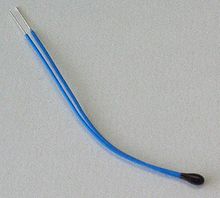Thermistor
A thermistor ( trunk word from English THERMally-sensitive resISTOR ) is an electrical resistor whose value changes reproducibly with temperature . Thermistors are divided into two groups in terms of their temperature behavior:
- NTC thermistors , which have a negative temperature coefficient (NTC) and conduct electricity better when hot than when cold
- PTC thermistors , which have a positive temperature coefficient (PTC) and conduct electricity better when cold.
Thermistors are used, among other things, in the field of electrical temperature measurement in the context of resistance thermometers or for limiting the starting current of electrical devices.
General
A characteristic of a thermistor is the change in resistance with a change in temperature. Metals, semiconducting metal oxides (ceramic materials) or silicon are used as resistance material , with both materials with positive and negative temperature coefficients being used depending on the application.
In the small-signal behavior , the dependence of the resistance on the temperature can be described as a linear equation with the proportionality factor :
- .
The factor is also known as the first-order temperature coefficient. Depending on the sign of this coefficient, a distinction is made between NTC thermistors with negative coefficients and PTC thermistors with positive coefficients. With thermistors, also known as NTC resistors, the resistance value decreases with increasing temperature. With PTC thermistors, also known as PTC resistors, the resistance value increases with increasing temperature.
Applications
measuring technology
PTC thermistor
Pure metals are PTC thermistors. In industrial temperature measurement technology, measuring resistors made of platinum, like the platinum measuring resistor, are common and standardized. With suitable equipment, they can be used up to 850 ° C. They have an almost linear characteristic with a relative change in resistance of just under 0.4% per ° C.
Designs with ceramic materials can be used up to around 200 ° C. Their characteristic curve increases in a narrow range around their nominal response temperature by up to 30% per ° C. In terms of measurement technology, they are hardly more suitable than for the statement "too cold / too warm".
Thermistor
Thermistors with negative temperature coefficients (NTC, NTC thermistors) have a high dependency on defects, such as the doping of the basic materials , due to the underlying semiconductor effect . Processing such as mixing, grinding, pressing and sintering has a major influence on the properties and long-term stability. For a long time, therefore, NTCs could only be produced with widely varying characteristics and, in their early days, gave NTCs the reputation of being unsuitable for precise temperature measurement.
NTC thermistors can be used up to around 150 ° C. Compared to platinum measuring resistors, they have a significantly higher sensitivity (reference value: at room temperature, the amount is a power of ten higher). Their non-linear behavior is described by non-linear equations. The preferred representation of the dependency is given under resistance thermometer. Another common form of representation of the non-linear relationship is the Steinhart-Hart equation .
Current limitation
PTC thermistor
PTC thermistors are used, among other things, for overload protection and for current limitation in continuous operation. Some PTC resistors made of barium titanate show a strongly non-linear relationship between temperature and resistance value and are used, among other things, as wear-free switching elements - comparable to bimetal switches . These types are used for over-temperature protection of electric motors; If the motor heats up too much, the output is reduced or it is switched off.
In other applications, PTC resistors are used as slow, self-resetting fuses or to control the demagnetizing current in color picture tubes.
Thermistor
NTC thermistors are used to limit inrush currents in order to enable a soft start . A thermistor in the supply line of an electrical device is cold before it is switched on, conducts poorly at the moment it is switched on and limits the inrush current purely ohmically . After switching on, it heats up due to the flow of current and reduces its resistance to the high initial resistance by more than 2 powers of ten. The use of a thermistor prevents a current spike, for example,
- if this could trigger an electrical fuse when switching on a power supply unit ,
- if this could damage a rectifier when charging a capacitor.
NTC thermistors for limiting the inrush current cannot be connected in parallel to increase the permissible continuous current. The smaller of the resistors would get the greater share of the current, would heat up faster, and the already warmer component would heat up even more. As a result, one of the thermistors takes over almost all of the current. A series connection is possible, however, if the aim is to increase the run-up time.
Designs
- Leaded discs or cylinders
- Surface Mount ( Surface Mounted Device (SMD). Square or, for example, SOT-23)
- Wired metal eyelets, pills or typical semiconductor housings (TO-92, TO-220)
- Screw-in metal housing
In addition, there are also historical designs such as the iron-hydrogen resistor , a PTC thermistor, and the NTC thermistor made of uranium dioxide , which is referred to as URDOX resistance.
Web links
Individual evidence
- ^ LW Turner: Electronics Engineer's Reference Book . 4th edition. Butterworth-Heinemann, 2013, ISBN 978-1-4831-6127-3 , Chapter 6: Electronic materials and components, pp. 6–30 to 6–41 .
- ↑ a b Ziehl: PTC thermistor temperature sensors ( PDF ), requested on January 31, 2012
- ↑ [1] , page 3
- ^ Thermistor Calibration and the Steinhart-Hart Equation, Application Note # 4. ILX Lightwave, company publication, accessed on September 28, 2014 .
- ↑ Michael Reisch: Electronic components: function, basic circuits, modeling with SPICE. Springer, 1998, p. 99
- ↑ [2] Data for inrush current limiters
- ↑ [3]







